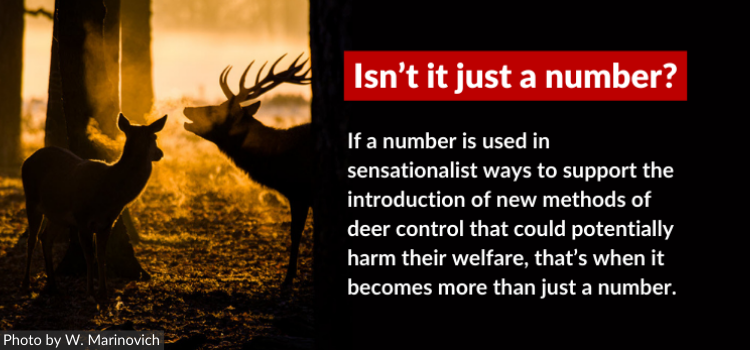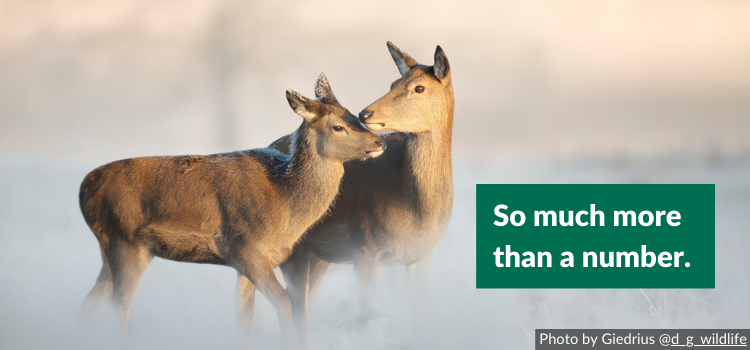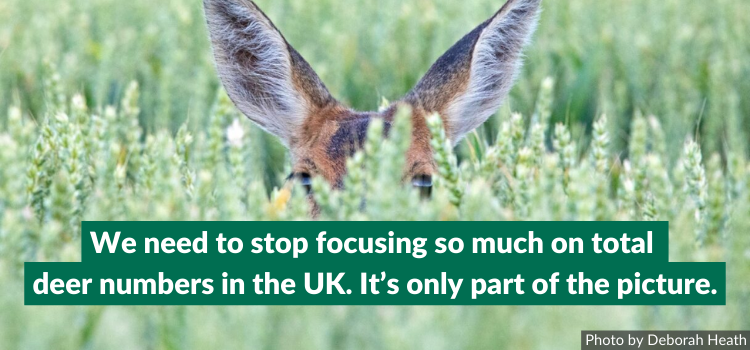Fact or fiction? UK deer numbers are at their highest levels in 1000 years – at around 2 million.
Share article:
Article by:
Andrea Barden, Campaign Lead, British Deer Society
“A lie gets halfway around the world before the truth has a chance to get its pants on.”
– Sir Winston Churchill.
THE STORY IN BRIEF:
UK deer numbers are uncertain: The frequently quoted figure of 2 million deer is highly questionable. In reality, no one knows for certain how many deer there are in the UK. Current estimates still rely heavily on outdated and limited data.
Deer welfare concerns: Using figures in sensationalist ways, especially when directed at policy makers and the public, can lead to harmful perceptions being developed that have a very real potential to negatively impact deer welfare.
A single number means very little. Total UK deer numbers alone will not help to develop a more effective, adaptive, and sustainable national deer management strategy that also protects deer welfare.
What needs to happen now? Fixating on the total number of deer in the UK needs to stop. Before making sweeping changes to our existing management strategies, we urgently need to address key gaps in our knowledge. This could start with improving our understanding of each of the populations of our 6 deer species right across the country.
How can you help? #speakup4deer. Help us spread the truth about UK deer numbers, Share this article, follow us on social, and get involved by signing up to our newsletter.

THE WHOLE STORY:
No one knows how many deer there are in the UK
“It is generally accepted that there are about two million deer in the UK. It is also accepted that one million of them are in Scotland. Allow me to unburden you from that notion. Nobody knows the exact numbers in England — nor anywhere else in Great Britain.”
– Dr. Al Gabriel, molecular biologist.
In 2009 the Parliamentary Office of Science and Technology tentatively suggested that the UK deer population numbered in the region of 1.5 million, while in 2018 The Mammal Society estimated that there might be somewhere between 750,000 and 1.6 million deer across England, Wales and Scotland. With a difference of nearly 1 million deer in this estimate, they were very careful to add that that it was based on limited data.
Fast forward to nearly 6 years on and we’re still in a similar position – but now we appear to be pulling guesswork into the data as well. This is guesswork that may serve a biased purpose and be based on little more than personal opinions.
Such opinions may or may not be driven by someone’s personal agenda, or also by something known as the ‘frequency illusion’.
This illusion occurs when something you’ve learned recently, such as “soaring deer numbers!” suddenly results in that thing, *deer”, seemingly appear everywhere you look. But are deer really appearing more often than they ever have before or are our brains just suddenly paying far more attention to them?
There are a number of possibilities. Perhaps the number of all our 6 species of deer, everywhere across the entire country, really are booming out of control.
Conversely, perhaps the numbers of all our 6 deer species are roughly what they’ve been for years – but thanks to things like ever increasing development and road use, combined with a recent heavy focus on tree planting, rewilding and similar pursuits, UK deer are now coming into more conflict with us than they ever have before. Increasing conflict could mean we’re all suddenly taking far more notice of deer than we did in the past.
Then again, maybe only some of our deer species are booming out of control, whilst others are stable or even declining? Going one step further – perhaps it’s even more complicated than that – with different changes occurring within different sub-populations of each species according to varying circumstances and local factors across the country.
Perhaps new technology, like drones, are helping us ‘see and count’ more deer than we’ve ever been able to before. One might then ask, are there really ‘more deer’ than there used to be or are we just counting them better?
The most likely scenario – is that it’s a combination of several of the above!
The truth of the matter is probably that, apart from a few better studied locations (such as the Scottish Highlands), we really don’t know what’s going on with deer numbers in the UK.

What’s in a number? Deer welfare.
We’re not exactly sure when or who started the game of ‘Pass it on’ with UK deer numbers ‘soaring’ and being at ‘2 million’– but as the saying goes, it’s all fun and games until someone gets hurt – and in this instance, it could very well be one of our most iconic symbols of the wild, our deer, that end up suffering the consequences of this not so harmless game.
How so?
Well, when such a number is used to suggest to the public that deer need to start being viewed as some kind of pest that are wreaking havoc across the entire country, it becomes quite worrying.
We all know that this kind of biased rhetoric only encourages those who already don’t consider deer welfare to be an important element of their management to disregard it entirely.
However, when such a number is used in sensationalist ways to support the introduction of new methods of deer control and management that could potentially harm their welfare, the issue becomes far more concerning.
See: BDS response to DEFRA consultation on proposed deer management strategy (England)
Ethical, effective deer management is so much more than just a number.
Whether we have a population of 2 million, 5 million, or even 10 million deer in total, managing them properly, ethically, and sustainably at the national scale depends on us also having a far better understanding of:
1) The makeup of that population (e.g. which deer species are where and in what numbers, and how many males, females and different age groups there are),
2) How our management practices, adjustments in our management practices and other factors (climate change, road use, landscape changes and similar) may influence the makeup of that population, and finally:
3) What exactly the ‘ideal’ total population is and what it will look like? (i.e. how many deer of which species can each type of our various natural habitats support without them negatively impacting other wildlife or efforts to rebuild and extend those habitats? How many deer of which species can our farmlands, suburban and similar habitats support without them causing conflict with farmers or endangering themselves or motorists on our roads?).
Having a more informed knowledge of all these areas will also mean we hopefully never come close to crossing that line where we’re all suddenly wondering where all our deer have gone.

What needs to happen now?
The sensationalism and consistent focus on ‘total national deer numbers’ or ‘soaring deer numbers’ that has been directed primarily at the public and policy makers must stop immediately.
It needs to stop before it initiates the implementation of misinformed management policies and legislation that may later be deeply regretted. This includes management changes that may directly or indirectly impact deer welfare through the encouragement of ineffective or poor practices, or wildlife crime.
Many would argue that sensationalist or agenda driven behaviour has already contributed towards some highly questionable management decisions being implemented in Scotland (see this article on the complete removal of male deer seasons there).
Instead, there needs to be an urgent focus on how we can improve our practical understanding for each one of our 6 deer species.
By filling in the existing gaps in our knowledge, only then can we be confident we’re managing our deer to the very best of our ability and that we are introducing new strategies that we are certain won’t ever negatively impact the standards of welfare in the sector.
Human activities and priorities have put deer in a situation where they need to be continuously managed. For that reason alone, they deserve far better than management based on only a handful of puzzle pieces and a great deal of guesswork.
HOW CAN YOU HELP?
In one simple way: #speakup4deer
Spread the truth about UK deer numbers.
Follow the British Deer Society on Facebook, Instagram and X (Twitter).
Share this article on your own social media.
Keep informed by signing up to our free newsletter: Deerbytes.
KEEP INFORMED & LEARN MORE ABOUT OUR WORK
Sign up to our free newsletter, Deerbytes, now.











